TOP NINE NEW RELEASES OF 2010
This is the stand-out new* music released in 2010 (Full reviews below)
CHEIKH LO (Senegal) World Circuit, UK
KONONO NO 1 (Congo) Crammed Discs, Belgium
SYSTEMA SOLAR (Colombia) Chusma, Berlin
BOMBA ESTEREO (Colombia) Nacional Records, Colombia
ORCH NATIONAL DE BARBES (Algeria) Chant du Monde, France
SECRETLY FAMOUS: SPY FROM CAIRO (Arabia) Wonderwheel, USA
JALI BAKARY KONTE (Gambia) Akwaaba, Cyberspace
D O MISIANI & SHIRATI JAZZ (Kenya) Stern's, UK/USA
KHAIRA ARBY (Mali) Clermont Music, USA
*D.O. Misiani's album is older material but in this case it was ALL new to me, so I am making an exception for it!
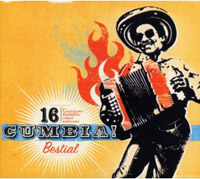
|
Favourite Comps:
Two of my Top 9 albums, Bomba Estereo & Systema Solar are also included on the sampler CUMBIA BESTIAL which is a great set of contemporary Colombian sounds. Also the videos are excellent: Bomba Estereo es aqui y Systema Solar aqui.
ROUGH GUIDE finally came of age this year, turning out great comps that went beyond the expected. Three of their efforts, Rough Guide to Bollywood (2nd edition), Rough Guide to Bhangra & Rough Guide to India play back to back in my iTunes frequently. |
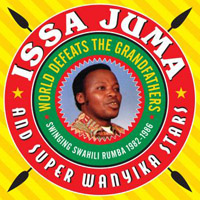
|
Reissue of the Year (tie):
Issa Juma & Super Wanyika World defeats the Grandfathers (Stern's)
Carlos Lamartine (Akwaaba)
I also enjoyed Abbu Omar & other Kenyan & Tanzanian oldies that I reviewed in October.
Live Show of the Year:
No concert of the year this year, definitely another sign of getting old! The word from my pals in New York & Chicago is that Khaira Arby was the hit of the year. I used to go to over 100 shows a year but that was in the last century. Still, in my couch-potato state I manage to watch YouTube and found these to be the most viewed of the year:

Shakira: Waka Waka
Recalls the excitement of waiting for each day's World Cup matches to start on Univision in the summer. |

Cee-Lo Green: Fuck You
Praveen, one of my students, sent me the typographic version of this. I loved it, then I discovered the cool retro-style music video. Then Cee-Lo did it live on BBC's LATER. It gets better & better. Retro sound with hints of Gap Band, Dazz Band, Stacey Lattislaw, Zapp & Roger too.

Sugar Minott: Good Thing Goin'
Greg Isaacs & Dr Remmy Ongala were among those who died this year, but inexplicably I was really moved by Sugar Minott's death, and found myself playing this Top of the Pops groover over and over. |
I uploaded a couple of African classics to YouTube this year, including the original "Shauri Yako" by Nguashi Ntimbo & Festival du Zaire.
TOP NINE RELEASES OF 2010

|
CHEIKH LO
JAMM (World Circuit WCD084)
Though he is Burkinabè, Lô's musical identity was forged in Senegal where he performed from 1978 to 84 with Ouza (check them out on the Senegal Flash series). He was born to Senegalese parents but grew up speaking Bambara, a language of neighbouring Mali. Lô converted to Mouridism, a sect of Islam that resisted the French colonizers, & he sang about his faith on his last album, Lamp Fall. It's been five years since that was released, but it was worth the wait. As carefully crafted as ever, this is a wonderful relaxed yet energetic set. I mean even on the fast numbers his tone is smooth. It's unplugged (apart from electric bass and occasional electric guitar leads) as Cheikh Lô reworks some classics from the Senegalese & Guinean repertoire, leaning more towards Cuban oldies than mbalax. Among the high-calibre sidemen here are Pee Wee Ellis & Thierno Koite on saxes plus Tony Allen on drums on two cuts. "Seyni" is a reworking of "Guantanamera," and done as a tribute to two of his heroes, (Gambian) Laba Sosseh and (Cuban) Abelardo Barroso. Just as it starts to turn into Baobab they quit. But the band also turn in a credible version of Bembeya Jazz's 1971 hit "Doni doni" (complete with pizzicato guitar), which they refer to by the opening line "Il n'est jamais trop tard (It's never too late)." Amadou Balaké's "Morico" from the 1978 album "Taximen" pops up. Another mellow cover is Doh Albert's "Moya" (from the 1979 Lassissi-produced album, "Du Belier"), which is revamped as "Ne parti pas (Don't go)." It is really pleasant to have Cheikh Lô give us this little tour of his personal jukebox: songs he grew up with, or started out singing. The band is tight but stretches out (notably the saxophonists), & Lô is in fine voice. "Dieuf Dieul," a religious song, is especially fine, but it's hard to single out tracks: the whole disc is exceptional. To promote the new album, which is still a pricy import in the US, WorldCircuit have released a free downloadable track and a bandwidth-hogging video on their website.
|

|
KONONO NUMERO UN
ASSUME CRASH POSITION (Crammed Disc craw60)
We can assume that Konono are flying high these days, and are also keeping a tight grip on their title of Number One. For their latest album with Crammed producer Vincent Kenis they have added a few novelties to the line-up. Young members of a Kin-based Konono cover band have been inducted into the ranks & a few guests from Kasai All Stars, who also appeared in the Congotronics series that broke this sound to a wider audience join in for a monumental jam. Other guest vocalists and guitarist Manuaka Pepe Felly have also jumped in to augment the three electrified likembes that build the trance zone. Traditional Bazombo trance music never sounded so good. The Zombo come from the southern mountains of Congo that border Angola and their traditions are handed on by group leader Mawangu Mingiedi who is now in his late 70s. The appearance of Manuaka (a founder of Zaiko Langa Langa) is a giveaway that "Konono Wa Wa Wa" is a tongue-in-cheek homage to "Zaiko Wa Wa Wa"-- a popular theme of Zaiko's that would crop up periodically during the melody jams in their concerts. Not surprisingly Zaiko were also interested in exploring folkloric material in their music in the early 70s and the "atalaku" (or shouters) are definitely part of a much older tradition. I am so glad this sound caught on, because I have been passionate about it since the 1987 appearance of OCORA's double cassette Musique Urbain à Kinshasa. With electrified likembes, percussion, yells and whistles you don't really need guitars, there's fuzz tone to spare. The sequencing is great so the intensity is always there, but with some variety in the vocal breaks; in fact I think this is better than their 1995 debut and surpasses their live album.
|
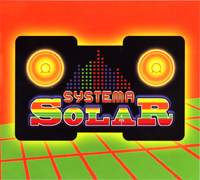 |
SYSTEMA SOLAR
SYSTEMA SOLAR (Chusma CR002)
This one leaps out of the speakers and grabs your vitals! Looking for things to fill the soukous void under my dancing feet I find the Colombian sound systems are really fitting the bill (& the cover design is bad enough to convince you of its legitimacy). Colombian sound systems are mobile, often pulled on donkey carts to move the massive speakers. Champeta is the raw ingredient, to which they have added scratching on old (truly scratchy) 1940s LPs, DJ toasting, with the exaggeration diction of r-r-r-r-r-r-adio announcers! and drumming and samples. This kicks off with wild enthusiasm and a track called "Bienvenidos" where they repeat "Systema Solar" over and over, against a pulsing bass, samples, scratched records and a wailing organ. "Mi Kolombia" starts in the street and layers on accordeon samples and a sickly wheezy funfair whirl of vocals & effects. It's ill and I love it. "El Majagual" features wild flauta de millo, which is a native instrument like a shrill reedy pennywhistle. After fifteen minutes it slows to a ballad then a techno ditty, called "Chico," that is skippable. But they are not giving up yet. What sounds like a souped-up Calypso oldie called "Firewire" is remade as "Fayaguaya." The live horns and vocals on this are fine. A dubby kind of thing --"Oye"-- follows that is okay in the flow because you are ready for a break. Speaking of flow it sounds like it's underwater. We stay in trance space for a while, with a fine clarinet popping up in "Amenaza." Then they wake up for a big finish with "Ya veras" and "Quien es el patron?," both back in the sh*t-kicking champeta mode. Overall Systema Solar's debut disc is well-sequenced & most enjoyable.
|
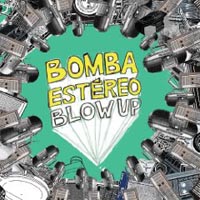
|
BOMBA ESTEREO
BLOW UP (Nacional Records.com)
This comes from the LA-based label that brought you Bostich and Los Fabulous Cadillacs. It's dance music with bits of disco, hip-hop, electronica, reggaeton, etc over some vaguely traditional Latin American armatures. I don't like all of it but I am wild about the debut single (track 2) "Fuego," which starts as a cumbia then a murderous drum loop kicks in (with a bit of police siren & a rocket-launch countdown) & layers of organ, bongo, bass drum and bass guitar fill it up to overflowing. On top of it Li Saumez delivers the "voz" as she does on most of the album. The loops, bass guitar and arrangements are by her partner Simon Mejia. There are two percussionists completing the line-up. I am not sure what it is -- champeta meets reggae meets house -- but whatever it turns out to be, Colombia is on the cutting edge of it. The new transglobal dance sound maybe. You can check out their sound and vision on myspace or youtube.
|
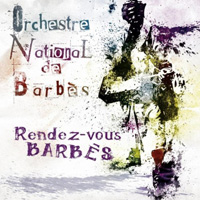
|
The members of this band are Algerian expatriates. For them Barbès is a suburb of Paris, so their rendez-vous is in the heart of France rather than their homeland. Though they are steeped in their culture they have modern attitudes to music, so they incorporate elements of reggae, ska and much else into their sound. Their style of Ska has been domesticated as "Oranais Ska." A heavy dub called "Chorfa" has moody sax and a very stoned backbeat. They call it desert dub, and it features the wonderful Gnawan singer Hafid Bidari. This track reminds me of Gnawa Diffusion: their Bab el Oued Kingston remains one of my favourite North African recordings. Though sometimes the reggae bits seem a bit slack (e.g. "Rod Balek"), when it's just a nyabinghi backbeat on the congas and the guitars and accordions are wailing in their North African scales I am quite transported to the casbah -- even if it is on the périphérique. And there's nothing more majestic than a 17-piece big band gradually building the tempo, nudging each other along to faster licks, greater displays of virtuosity. After some showing off, they get to the heart of the matter: the krakrebs (iron castanets) and guimbri (heavy bass guitar-like lute), an ancient sound, augmented by a guest appearance by the Gnawan band Bania on "Laâfou." I believe this is their first album since the 1998 En Concert, another gem. Lead singer Ahmed Bensidhoum plays bass derbouka and is apparently a Franz Ferdinand fan. Lead guitarist Khliff Miziallaoua admires Jimi Hendrix. Other vocalists double on percussion instruments. They reach out to Flamenco, Jazz, Rai (the title track) and Gnawa styles, drawing on the diverse talents in their ranks for a satisfying tour of the North African musical landscape.
|
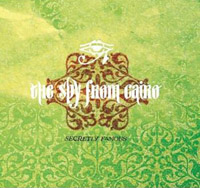
|
THE SPY FROM CAIRO
SECRETLY FAMOUS (Wonderwheel)
This is a collection of dance tracks from Arabia with diverse source material treated to electronica and a dubby sensibility. The album title is a bit of a joke because the Spy is Moreno Visini who has appeared on scores of DeeJay comps from BUDDHA BAR to the Zeb albums. But fame in the world of DeeJays is hardly front-page. The album kicks off in style with the high-pitched whining sound of the nay (a bamboo flute) blown at a Jordanian wedding, though it sounds like a wedding of snake-charmers. It is reminiscent of Arabic Groove, Michael Jackson as envisioned by Fellini, and indeed Spy movies! There's oud and darbouka (the traditional percussion) and Visini has added a dubby bass line to push it along. Because we think of arabic music as inherently trance-like it's a good mix of repetition and mood-setting themes. This one is likely to supplant Arabic Groove on the popularity front. It has the same diversity, from belly-dance to Sufi trance, & is just as catchy and compelling. "Kurdish delight" continues the nay theme, and the dub attack, with a breakdown to bass, drum loops and something that sounds like shorting-out wires or a sound-board on the fritz. Tunisian woman singer Ghalia Benali shows up for the first of four appearances on "Ana Arabi," a song about being an Arab, not a terrorist. There's a flat spot in the middle then things perk up with wild violin on "Leila." "Sufi disco" is a humorous name, because it's the spaciest track on here. You kind of forget where you are, until the bass and tambourine kick up a sandstorm for the next track, "Saidi the Man." This has wild flute and a cheap synthesized rhythm reminiscent of Bollywood soundtracks from the 70s. Then suddenly we are whisked to the Atlas Mountains by "Reggada," a very different sound with that dusky Joujouka flute emerging from a big cloud of smoke.
|

|
JALI BAKARY KONTEH
KONTEH KUNDA (Akwaaba Music AKW016)
Jali Bakary Konteh, as his name implies, is a musician. He plays the kora which, with the rise of Malian music & the Grammy success of Toumani Diabaté etc, is becoming a well-known sound in the West. There are some videos of him in action on YouTube to give you a sense of his style. He comes from a long line of Gambian kora players and both his father and grandfather recorded and helped popularize the sound. His grandfather, Alhaji Bai Konte, one of the greatest exponents of the instrument, recorded Kora melodies from the Gambia (which Rounder released in 1973 -- and recently reissued on CD). His father, Dembo Konte, added more strings to the 21-string instrument and recorded widely, including a trio with Mawdo Suso (balafon) & Kausu Kuyateh (also on kora) called Jaliology (Xenophile) that was a hit in 1995. On his debut album, J. B. feels right at home with trap drums and slide guitar backing him. Hell there's even reggae drums and echo on an otherwise very traditional sounding "Jaraby"-- all credit to the fine production by Steve Pile (who overdubbed the Western instruments himself). There's also Afrobeat horns and flute on "Combination" the single from the album which is getting airplay, even back in Gambia, which pleases Konteh because not only his father and grandfather, but even his cousins have albums out. All that aside, a fair amount of the album is devoted to just the kora and it is a joyous sound, pure and simple. Several of the traditional tunes have been recorded by both his forebears. Recorded live in Konteh's compound (the album title means House of Konteh), you hear night insect sounds with their own natural percussive insistence as the heat rises from J.B.'s fingers.
|
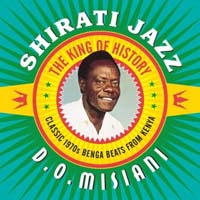
|
D. O. MISIANI & SHIRATI JAZZ
THE KING OF HISTORY (Sterns STCD3051)
The first thing you have to be ready for with Benga music is the shrill voices. They are not unnaturally high like Bollywood playback singers, but still they strain up an octave. Then you can get into the sheer propulsive energy of it. It is perhaps the speediest music from Africa, and it is stripped for action: two guitars, bass and drums with only occasional sax, or even bottle percussion. Misiani is (or was) the master: this collection comes from the 1970s, which was his greatest era. Misiani, a talented guitarist himself, brought up on Losta Abele, Bosco, et al, assembled the best possible band -- so you don't have a rhythm guitarist strumming on an open chord, a bass playing the one and a drummer keeping a four-square beat: you have four individuals playing their hearts out from the word go. The bass is the most unusual: he is soloing throughout, paying very little attention to the tune or the other musicians. The two guitarists also don't really play together, they make little musical sorties, only occasionally at the same time. The drums are quite bizarre actually. In his classic novel, The Music in my Head, Mark Hudson has a very funny passage about the greatest air guitar song of all time: He goes on about this gem of rock & roll, and then says that when the drums come in they are so badly recorded it ruins everything. The Kenyan drums are not badly recorded, just badly made, I think. They sound like plastic buckets, very different from other trap drums on record. But the high energy guitars and insane bass soloing completely overwhelm any need for sonic fidelity on the tubs. Amazingly, the two albums released in the UK in the late 80s presented a strong showing of Misiani's music, and hooked a lot of us on Benga, but this earlier material is even better!
The CD notes don't say who is on here. However the 1989 album PINY OSE MER, which has liner notes by Werner Graebner, lists D.O. as bandleader, solo guitar and voice, Ochieng Oninga as first rhythm guitar, Juma Obai as 2nd rhythm guitar, and Nyabuon Nyang as merely the rhythm guitar. Two bassists are identified: Okech Oro and Pasy Aloo, with Caleb Odemba on drums. I don't know how many of them were in the band two decades earlier. Trying to explain the name, a fan said "Benga is the feeling you get when dancing." The music was influential in neighbouring Zambia and Zimbabwe, but also as far away as Nigeria where it was popular among fans of Ibo highlife. The direct influences on the sound might be traced to the orutu, a traditional one-stringed violin, or the nyatiti, the 8-stringed lyre. These can be heard on the Hugh Tracey recordings of the 50s, if you want to look for parallels in the rhythm and lead guitar. Although the Luo are only the third-largest ethnic group in Kenya their music became hugely popular in the 70s and eclipsed the other forms of Swahili- and Congolese-language dance music in East Africa. Misiani's pointed lyrics (couched in fables and folk tales) often got him in trouble with the authorities, and he was once arrested as an illegal immigrant (being from Tanzania) but not deported. At their peak Shirati Jazz sold 20,000 singles a month in the 70s, but in the 80s piracy and cassettes severely dented the African music industry. Misiani, who died in 2006, would have been amused that Barack Obama, son of a Luo man, became president of the United States while Kenya has never had a Luo president, Doug Paterson tells us in his liner notes. The booklet includes photos and translations of all the songs.
|
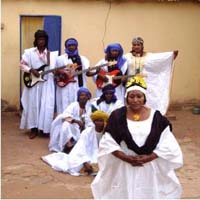
|
KHAIRA ARBY
TIMBUKTU TARAB (Clermont Music)
The glittering lure of Tombouctou has faded of late, with tales of kidnapped tourists, so we are back to listening to the music and doing some armchair travel, rather than planning to brave sandstorms and spitting camels to get there. Khaira Arby is a traditional Songhai and Berber praise singer from Mali, untouched by the Western ideas that pushed her compatriots Issa Bagayogo and Rokia Traore into the international spotlight. She sings about people, the anguish of women, religious festivals. The Duchess finds it high-pitched and complaining, but when you are relating tales of female excision or exhausted workers returning from the salt mines, it's hard to be light and airy. Arby has surrounded herself with a band of three rock guitars in addition to fiddle and ngoni. Even the calabash is backed by a western drumkit, so the album has drive, to say the least, and it was demonstrated in person as she backed her words with actions on a North American tour in 2010, hoping to become as familiar (& popular) as Salif Keita, Toumani Diabaté, Vieux Farka Touré, or Tinariwen to the American concert audience. Word is her live shows are a knock-out. While it does seem as though she is trying to cram Ali Farka AND Oumou Sangare into the same package, the power rock may be necessary to get attention. But it is the traditional aspect of her music that appeals to me: when it comes down to the njarka and backing female chorus trading licks against her strong vocals, with handclaps and calabash creating the rhythm. She moves back and forth between the more traditional praise songs and the rock-inspired outings that should appeal to a broad spectrum of listeners.
|













